Game Previews from Slitherine-Matrix Press Days 2012 – An ACG Report

The Slitherine-Matrix Press Days 2012 provided a peek at several wargames currently in development by Slitherine-Matrix and associated development companies, such as Legends of War—Patton’s Campaigns, shown in this screenshot, developed by the Spanish studio Enigma. Eddy Sterckx covered the April 23–24 in Stresa, Italy, for Armchair General. All screenshots were provided by the publishing or development companies involved.
The biggest challenge facing digital strategy and wargaming today is visibility. Gone are the days when gamers could pick up a box of The Operational Art of War from their local software shop’s shelf, and mainstream game magazines have gone totally mass-market and stopped reviewing this niche market. Realizing the importance of getting the word out that wargames are not only still being made, but are thriving, even. Slitherine/Matrix organizes a yearly event where they gather their (European) developers and invite members of the press to listen to presentations of new and upcoming games. Armchair General asked me to cover the 2012 event, held April 23–24 in Stresa, Italy.
{default}This article will try to give an extended overview of what strategy and wargamers can expect from Slitherine/Matrix in the upcoming year. Instead of boring you with endless feature lists, I will try to highlight those features I deemed interesting and/or noteworthy. So, yes, this is somewhat subjective, but I hope at least some of the enthusiasm developers show for their games will come across. This may be a software niche, but it’s an extremely vibrant one: In 2011 Slitherine/Matrix increased their gross revenue a staggering 67%, allowing them to hire a couple more people and to further develop the technology they can offer to their developers.
The centerpiece here is their PBEM+ server, which on top of the standard turn-exchange, match-making and lobby features, will be further developed to include sophisticated anti-cheat measures and integrated in-game forum messaging for a tighter and more seamless online game experience. With 5K to 10K multiplayer games going on at any single time, it seems wargamers appreciate the effort poured into this.
The company also managed to get more visibility in the market with some recent coups: Amazon will distribute physical copies of their games and a deal with HISTORY Channel was signed only a couple of weeks ago, allowing them to use the well-known brand name.
OK, enough generalities—it’s time to let the developers, the real stars, step into the limelight. So, on with the show!
Decisive Campaigns: Case Blue
Developer Victor Reijkersz first came onto the wargame scene about a decade ago with a beautiful little tactical WW2 game called People’s Tactics. The most surprising aspect of it was that it was distributed as freeware. I remember a lot of people commenting on "having bought games that were far worse" and that they "would pay for a game like this." Victor took them at their word, expanded and upgraded his game. Commercially published under the title Advanced Tactics, it was released to both critical and public acclaim.
Wargamers, being who they are, clamored for more, and again they got what they asked for: the Decisive Campaigns series was launched in 2010, with "The Blitzkrieg from Warsaw to Paris" as its first title. This was more of a serious historical simulation than Reijkersz’ previous games, and building on its success we’re now getting Decisive Campaigns: Case Blue, which focuses on the Ukraine-Crimea-Caucasus region of the Soviet Union from the start of the German 1942 summer offensive to the Russian counteroffensive dubbed Operation Uranus. This period and geographical area saw major offensives by both sides, so it’s a gamer playground with some serious challenges for both the German and Soviet players.
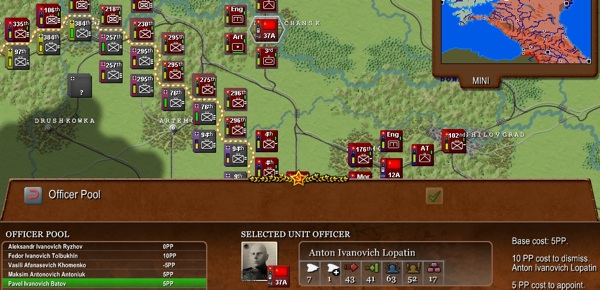
Decisive Campaigns: Case Blue utilizes a slightly different user interface depending on which side you play.
The map is 160 by 125 hexes, 10 km to a hex. The game uses two-day turns, and three major campaigns provided: the aforementioned Case Blue, Operation Uranus and a campaign focusing on the exploits of the German First Panzer Army, all in a series of linked scenarios with unit casualties being carried over to the next scenario. It’s at the regimental level, so the big scenarios will have 700-800 units per side, but there will be a number of smaller battles, too—Second Kharkov and others.
What I find interesting about this title is that while the focus is on providing a strong historical simulation, gameplay is not dry; care was taken to create the right atmosphere. The graphics, the in-game text (such as biographies for all 150 of the included generals), even having a slightly different user interface depending on which side you play—all serve to get the gamer really immersed. Easy replaying of the opponent’s moves in the history screen and a particular zoom level that allows for multiple stacked units to be visible at the same time are just two other examples of the care that has been taken to ensure a smooth gaming experience. The aforementioned PBEM+ is supported, too, of course.
So what’s new? In short: High Command orders—in essence sub-challenges within the greater framework of the scenario, generally of the "take location X within Y turns and earn Z prestige points" type of challenges. These prestige points can then be used to buy extra troops, but what’s really a new twist is that they can also be used to change the high level objectives. This simulates the player, through his successes, having more influence on OKW/Stavka strategic plans.
Action cards, both high-level and one-time-use ones, and action cards linked to particular officers play a role, too. By changing around officers from the command pool and spending command points gamers can influence the behavior of individual units, giving just that little extra boost that’s sometimes required for taking the objective.
Finally, another new feature is that the game will come with an editor allowing gamers to come up with their own maps and units. It even allows for scripting events and rules.
Panzer Corps – Afrika Korps
Developer Alex Shargin was smiling from ear to ear during the presentation, and why shouldn’t he? As the developer of the smash hit that is Panzer Corps he had excellent reasons to be happy. Panzer Corps is the re-imagining of one of the grail wargames of the Nineties, Panzer General, the perfect marriage of simple mechanics and addictive challenges. The recipe of 800+ different beautiful 3D units combined with simple 2D map graphics means that the game is very accessible.
Playability was a key design factor, and it shows in little things like in-game help texts and context tooltips that ensure you can start playing instantly without having to struggle through a manual or tutorial first.
Panzer Corps was just released in 2011, but gamer demand for more is so huge that six DLCs (downloadable content) have already been released, six mission packs that each deal with one year of WW2. You can migrate core units from one DLC to the next, so real addicts can even create a "grand campaign" by linking and playing them all in succession.
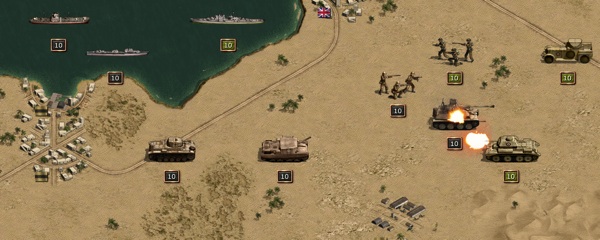
Panzer Corps—Afrika Korps, now in beta, will take players to the lair of the Desert Fox.
To put some numbers on how popular the game really is, there are 2,000 multiplayer games going on at any given moment on the PBEM+ server—and even then, the team reckons that 90% of the games are still played against the AI.
Not wanting to sit on their laurels they’ve now unveiled a number of upcoming releases.
First up is the 1945 DLC, which will complete the saga and allow gamers to play the entire war from start to finish in one huge linked campaign system.
Next is "Afrika Korps," currently in beta, which will have new desert-specific graphics, new units like gliders and mobile rocket launchers, and will come with a separate campaign of 20 scenarios. Expected release date is Q2-2012
What’s even more exciting is that a port of the game to the Mac and the iPad platform is planned. The plan is to do a complete port that would allow seamless multiplayer gaming against other gamers on a standard PC, something that is going to become really important in the near future. The iPad version could be in our hands as soon as Q3-2012.
And it doesn’t stop there: a Western Allies Campaign is also in the works. Not much more detail is known at this time and even less about a possible Fantasy Corps or Pacific Corps.
Close Combat – Panthers in the Fog
For the past couple of years Slitherine/Matrix have released under sub-license updated versions of existing Close Combat games, a very popular real-time, squad-based WW2 series from back in the Nineties. So it was a real surprise when they announced that they have just signed a deal making them full owners of the license and the trademark name. This will allow them to take the series wherever they like.
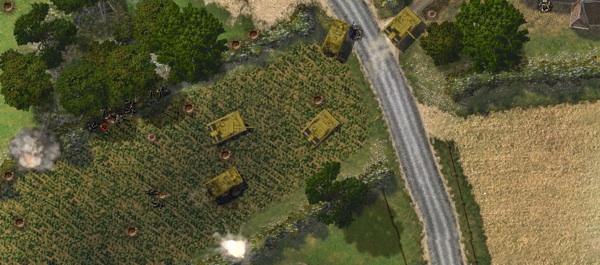
Panthers in the Fog, set during the Mortain Offensive of 1944, will be the final release in the popular Close Combat series to use the existing engine. The first CC games using the new engine are expected in 2013.
As a first step, an entire team has been put to work rewriting the existing engine on Unity, which will allow them to quickly port the games to PC, Mac and even iOs and Android devices. The new engine will be full 3D but will retain the familiar top-down viewpoint that gamers have come to expect. Games that we will see based on this new engine are undetermined as of yet, but will definitely be WW2. Earliest date we can expect something here is 2013.
But gamers won’t have to wait an entire year for another Close Combat game. Developer Phil Veale is working on "Panthers in the Fog," the last game that will be based on the current engine. It’s set during the Mortain Offensive of 1944, which pits the best troops Germany still had available against the best of the Allies. In 35 linked battles 50 different unit types and weapons will duke it out in 32-bit graphics—newly upgraded from 16-bit. The total squad control count has also gone to 21, allowing for larger and more involved scenarios.
Changes to the user interface also include a more historically accurate force selection and an improved strategy layer with animated unit movement. Artillery and air support will now be available on the strategic map. ETA is Q4-2012.
Commander: The Great War
After taking some good-natured flak for being late on a title that was promised for 2011, developer Tim Van Der Moer revealed some details of where The Lordz have taken the turn-based Commander: Europe at War engine. In fact, they’ve not taken it anywhere—the entire engine was rewritten from scratch to make porting it to different platforms possible. A Mac version is "very likely," but they’re also looking at the iPad and even more importantly have coded it as the first game in a series, making it an engine, not a single game.
Another design decision was to make the engine such that in-game tutorials and lots of tooltips do away with the need to read a manual; the gamer should be able to dive straight in. Commander: The Great War will feature multiple campaigns, each starting in a different year. Forty different events are in there, some of which will occur on a fixed date, while others will be variable and based on player actions. For example, the USA entering the war is partially driven by how much the German player restricts his U-boat warfare.
All the chrome you’d expect from a WW1 game will be present, from Zeppelins on anti-sub or recce missions, to early war ammo shortages that make stockpiling ammo before a big offensive a necessity. Little things like troops auto-entrenching up to three levels but then losing morale when you leave them stationary in the trenches for too long really capture the period in a big way.

The long-awaited, much-anticipated Commander: The Great War is scheduled to make its appearance in the second quarter of 2012.
Railroads are used to shuttle troops around. Armored trains and railroad guns also make an appearance, and research can give you a technological edge over an opponent but will cost valuable production points you need to buy or upgrade your troops.
Losing a capital ship or getting your capital bombarded will reduce national morale, possibly causing your nation to drop out of the war. Italy can switch sides based on diplomacy and certain events. Commanders can be attached to units and give them modifiers in combat, e.g., an air unit with Manfred von Richthofen will have an edge but at the risk of losing this commander. In a particularly evil twist, those modifiers can also be negative: a commander who’s to prone to sending his units "over the top" will have a negative influence on units within his command radius.
Special mention was made of the AI, which should be really good, as The Lordz have had a dedicated AI programmer working on it for the past two years. All of these goodies will become available in Q2-2012
Legends of War – Patton’s Campaigns
The new offering from the Spanish studio Enigma, represented at the event by Daniel Parente, is a bit different in that it was designed from the ground up to be played on a console (PS3, Xbox360 or PSP) but is squarely aimed at a wargamer audience. It’s a full 3D, turn-based tactical game dealing with the 1944 campaign of the Allies in WW2—basically D-Day to Berlin—in combination with a high-level strategy game
The game is mission based—35 in total—played on 13 maps with a destructible environment. You can earn experience points in each mission that you can use to buy more units. In-game cut-scenes combine the missions into a story. The game can be played against the AI or in hotseat mode; multiplayer will be put in at a later date. A retail worldwide release is planned for this one. See the screenshot at the beginning of this article.
Sovereignty
Developer Tim Van Der Moer also gave us a quick look at this game in development. It’s still in pre-alpha, so its features are not set in stone yet, but at the moment it’s a turn-based, high-fantasy strategy game set in a world akin to Middle Earth or Westeros, divided up in numerous regions. Various races—the usual suspects of orcs, dwarves, elves, undead, etc.—battle, trade and undertake diplomatic missions to come out on top.
Combat is based on a card system,but that may change during future development. What is certain is that players will definitely need to develop and manage an economy, so it’s not a pure combat game. Multiplayer will use the PBEM+ system mentioned above.
The game is projected for release Q1-2013, and an iPad version is a definite possibility.
Conquest
Another two-minute presentation by Tim Van Der Moer is a game that he described as "Angry Birds for Strategy Gamers," a hex-based conquest game for the "touchy stuff"—iPhone, iPad and Android systems. It should be released in the first half of May 2012 with a $1.99 price tag.
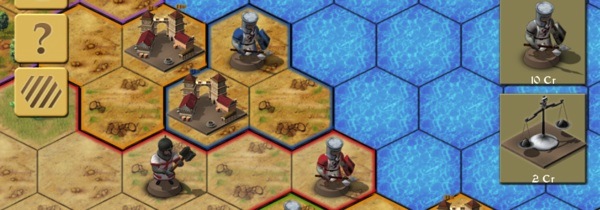
Tim Van Der Moer describes Conquest as "Angry Birds for Strategy Gamers."
Pandora: First Contact
Pandora: First Contact was the last of the big presentations, but certainly not the least. The buzz is already high on this one, and developer Lorenz Ruhmann gave us an in-depth look at what this turn-based, sci-fi, post-WW3 game will look and play like.
This is a 4X game to the bone, heavily inspired by the game Alpha Centauri. Explore this new world called "Pandora," harvest its minerals and food, and expand your colony by engaging in diplomacy and warfare. Tech research can give you an edge and you’ll need it. Indigenous life forms will be a constant threat, as if you didn’t already have your hands full fighting off the other factions.
What distinguishes this game is that the developers are aiming at creating four distinct and viable paths to victory, all equally powerful: a diplomatic one, in which becoming planetary governor is the ultimate goal; an economic one, in which you, in essence, buy out the other factions; a scientific one and, of course, a military one. Each of the seven possible factions have a basic trait, such as scientific, ecological or fanatical that gives them an edge along a particular path, but that’s only a bias, not a predetermined path.

Pandora: First Contact promises four distinct and viable paths to victory, all equally powerful.
To avoid the lather, rinse, repeat feel of many 4X games this one evolves over three distinct eras: an initial colonization phase in which you establish your colony; a mechanization phase wherein you build-up your empire; and a transcendence phase in which—in a nice twist—the indigenous intelligent alien life-form returns and wants its planet back.
Units are customizable and come in the familiar classes of basic trooper, tank, aircraft, watercraft, mech, etc. Each unit has three tiers, one for each era, and the same concept goes for the weapon classes. Damage is dependent on type and unit and is offset by armor. On a higher level gamers can engage in operations like using satellite reconnaissance, nano repair bots, and even nukes.
All of this should come out for the PC, Mac and even Linux starting from Q3-2012
Odds and ends
The much-belated port of the boardgame Conflict of Heroes will finally be released in May 2012. From recent screenshots it’s immediately clear why this one took a bit more work than anticipated. The "Storm of Steel" expansion is already announced for Q4-2012.
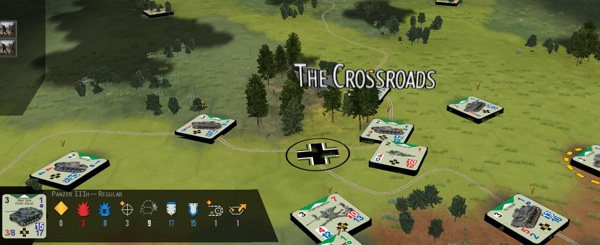
Conflict of Heroes, which wowed many boardgamers in its cardboard-and-dice version, is coming to a computer screen near you.
Talking about much belated developments: World in Flames, the über-monster game of WW2, is also slated for a Q2-2012 release. To give you an idea of how big this game is, if the world map was printed out it would be 27 feet long.
Finally, the third of the Big Three boardgame ports—Lock ‘n Load Heroes of Stalingrad—will come with both a German and Russian campaign and will be available in Q3-2012
Field of Glory: there was a temporary halt to this ongoing success story, but now a new developer is working on it, rewriting the engine so that the series can move forward again. A Mac version is planned and the next couple of releases should be "Oath of Fealty" (Feudal era) and "Wolves of the Sea" (Vikings). It came as no surprise that iOs and Android versions were announced, too; the game is simply made for the tablet format. Q4-2012.
Great Battles Medieval, the showcase wargame for the Android platform, will get an iPad version in Q3-2012.
And finally, on the mobile game front: Battle Academy, touted as being the only real wargame on the iPad , will be getting two expansions. An Android version is also slated for Q4-2012
This press event only covered the European side of things, but there’s lots of stuff in development on the other side of the Big Pond as well. I know it’s a bit outside the scope of this article, but I can’t let the opportunity slip to mention that Frank Hunter is working on a Fortress Europa game, the SSG guys are doing a Complete Carriers at War, and Gary Grigsby, et al, plan to have War in the West out in 2013. And that’s just the tip of the iceberg.
In conclusion. I think it’s fair to say that wargamers have a lot to look forward to and that it seems mobile wargaming on the tablets will be coming of age this year.
About the Author:
Eddy Sterckx is a software engineer who’s been playing digital wargames from when they sill came on floppy disks, and the paper kind from back in the Stone Age when AH and SPI were kings. He hangs out at all the usual grognard spots and can be privately contacted at eddysterckx@hotmail.com.

